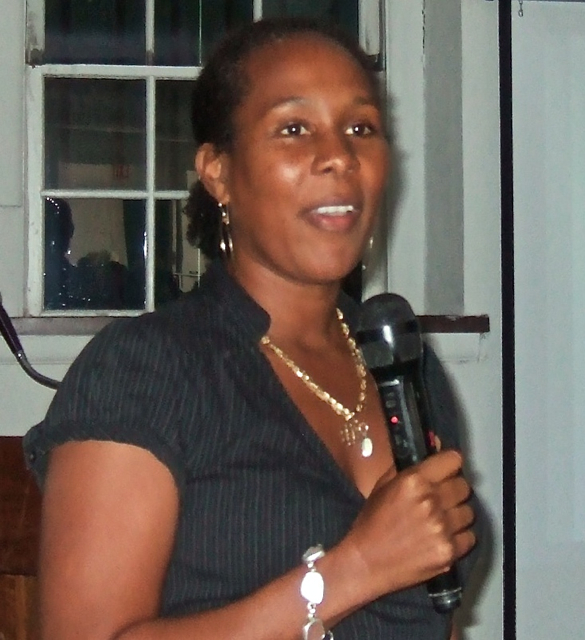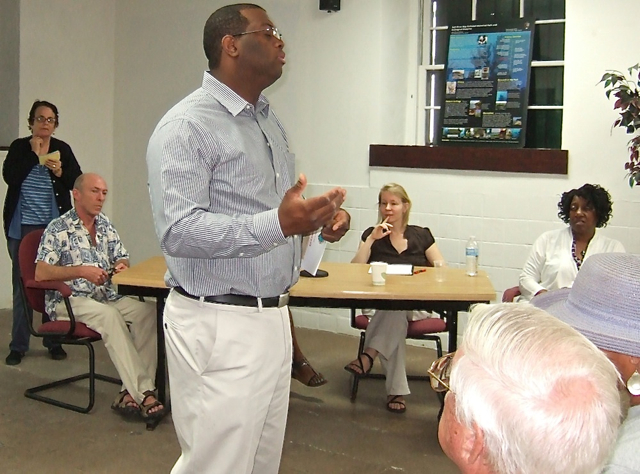
Presenters also talked about national and worldwide efforts to educate the public about slavery at the historians’ 27th annual conference, which was held at the Christiansted National Historic Site, Danish Guinea West India Company Warehouse/Slave Market Building.
Gunvor Simonsen is an assistant professor at the Saxo-Institute of Copenhagen University who has studied 17th, 18th and 19th century Danish records for more than 10 years. Her sources included the Danish National Archives. Her presentation focused on the evolving acceptance of slaves into the Danish courts, as plaintiffs as well as defendants and witnesses.
In the beginning, she said “most slave activity was criminalized” and testimony by slaves was not considered legal evidence. Simonsen said she found no court documents in the 18th century Danish West Indies with slaves as plaintiffs. Her research identified enslaved testimony only as witnesses using “the faintest phrases,” to describe incidents that could have been physical and sexual abuse.
But by the 19th century, slaves had “drafted strong narratives of themselves as Christians and respectable men and women, defined not by being enslaved,” Simonsen said. They identified themselves as sentimental and compassionate individuals with a good work ethic who loved and cared for their families.
In one of the first cases, in 1803, a woman named Peggy was complainant, charging her owners with mistreatment. She said she ran away after the wife threatened to “torment her to death slowly.” The landowners were compelled to defend themselves in court and other witnesses testified regarding Peggy’s good character. Simonsen said the case eventually was heard by the Supreme Court and the defendants were fined. Ultimately, Peggy was given her freedom.
In 1829, Cecilie, another enslaved woman, testified in court about sexual abuse by the property owner. Reportedly, Mrs. Davis, the master’s wife, interrupted the rape and brutally flogged Cecilie. In court, Davis said Cecilie’s charges were “terrible accusations” and Mrs. Davis told the judge that flogging was not a harsh punishment. In turn, Cecilie’s father said he had a first and last name, demonstrating his Christianity, and testified that Cecilie had been baptized.
Simonsen said the case was resolved with an out-of-court settlement that imposed a fine on Davis.
By 1832, Simonsen said the enslaved had become familiar with the law and called on family and friends as character witnesses. They learned the appropriate terminology to describe abuse and presented their cases successfully with the help of family and friends, who confirmed good character.
La Vaughn Belle, professor at the University of the Virgin Islands, talked about former slaves living in Christiansted town as early as the 1700‘s. With information from historian George Tyson, Belle discovered the original owner of the property she is renovating – Elizabeth Abraham. In 1777, Abraham was a freed slave, originally from Africa, who bought her freedom and a home and eventually passed ownership to her son.

The NPS program was the result of legislation passed in 1990 and the National Underground Railroad Network to Freedom Act of 1998. Jackson talked about locations with documented stories of resistance in Maryland, New Jersey, Florida, Delaware, Rhode Island and Connecticut.
“You might have noticed I did not mention your area because I need your stories,” Jackson said, adding that information about the program can be found on the website nps.gov/ugrr.
The Railroad is not “hidey holes,” Jackson said, but is a story that spans from Africa, across the Atlantic Ocean to the Caribbean and the U.S. She said the Underground Railroad is defined as “resistance to enslavement through escape and flight.”
“There is not one place that can tell the story because the story is so complicated,” Jackson said.
The other education program discussed during the meeting is under the auspices of UNESCO, Denmark and the Virgin Islands. Peder Wieben, coordinator of the National Danish Transatlantic Slave Trade School described an educational program that includes 9,000 schools worldwide. A website, www.emu.dk, allows students and others to learn about slave trade history, including cases on St. Croix, and an online game developed by students.
The Virgin Islands-Denmark program includes 20 Danish schools and St. Croix Central High School, St. Croix Educational Complex and The Good Hope Country Day School.
“The basic idea is the different school forms inspire each other,” Wieben said.
Duane Howell, chairman of the St. Croix Landmarks Society and advisor to the Danish UNESCO project, talked about a new collaboration between Complex and Danish gymnasium (hight school) students. A St. Croix English teacher will guide Complex students as they produce a 30-second video about local folklore and the Danish students will do the same. Both groups will interpret the stories and then talk about each others legends.
“It’s important because the transatlantic slave trade is a topic that can be implemented across the curriculums,” Howell said.
Other speakers at the annual meeting included Chenzira Davis Kahina of the V.I. Caribbean Culture Center, and Lauren Larsen of the V.I. Education Department. Tributes were given to deceased historian members Pat Murphy, Ken Barta, Robert Merwin and Jayne Edwards.
Two groups of students were introduced during the meeting, including students from Copenhagen working with local schools on slavery projects and two NPS interns from Overland College.





